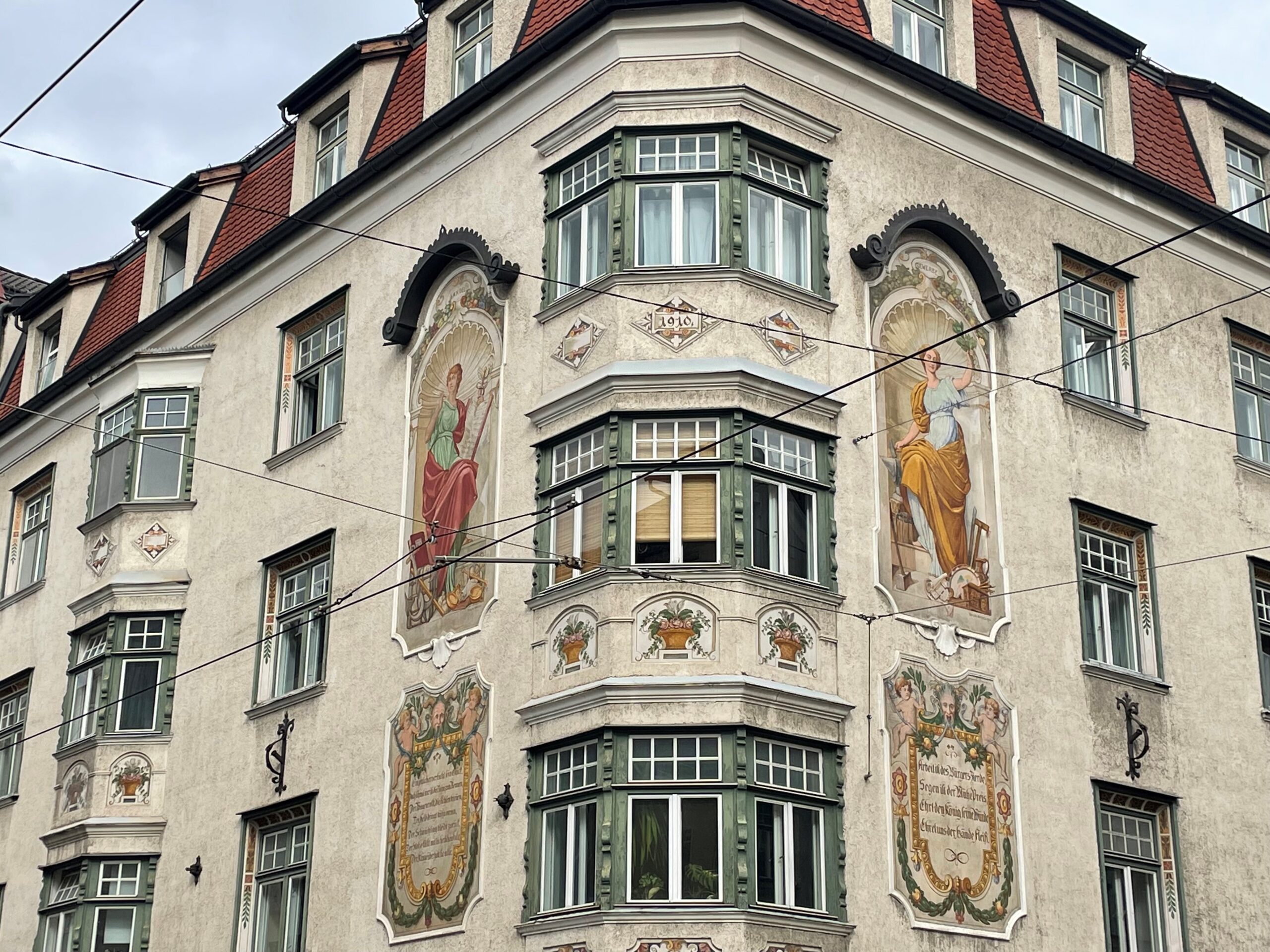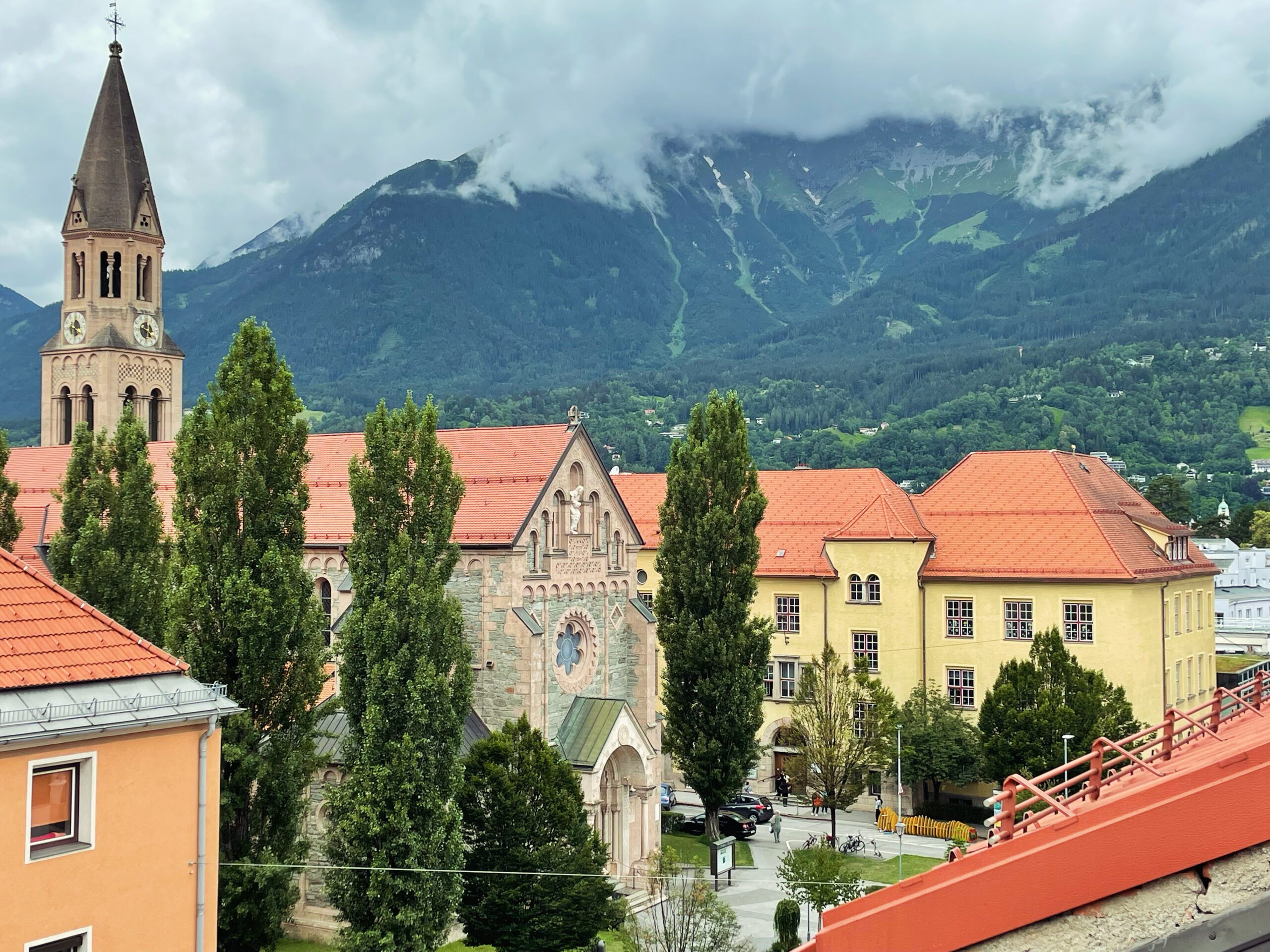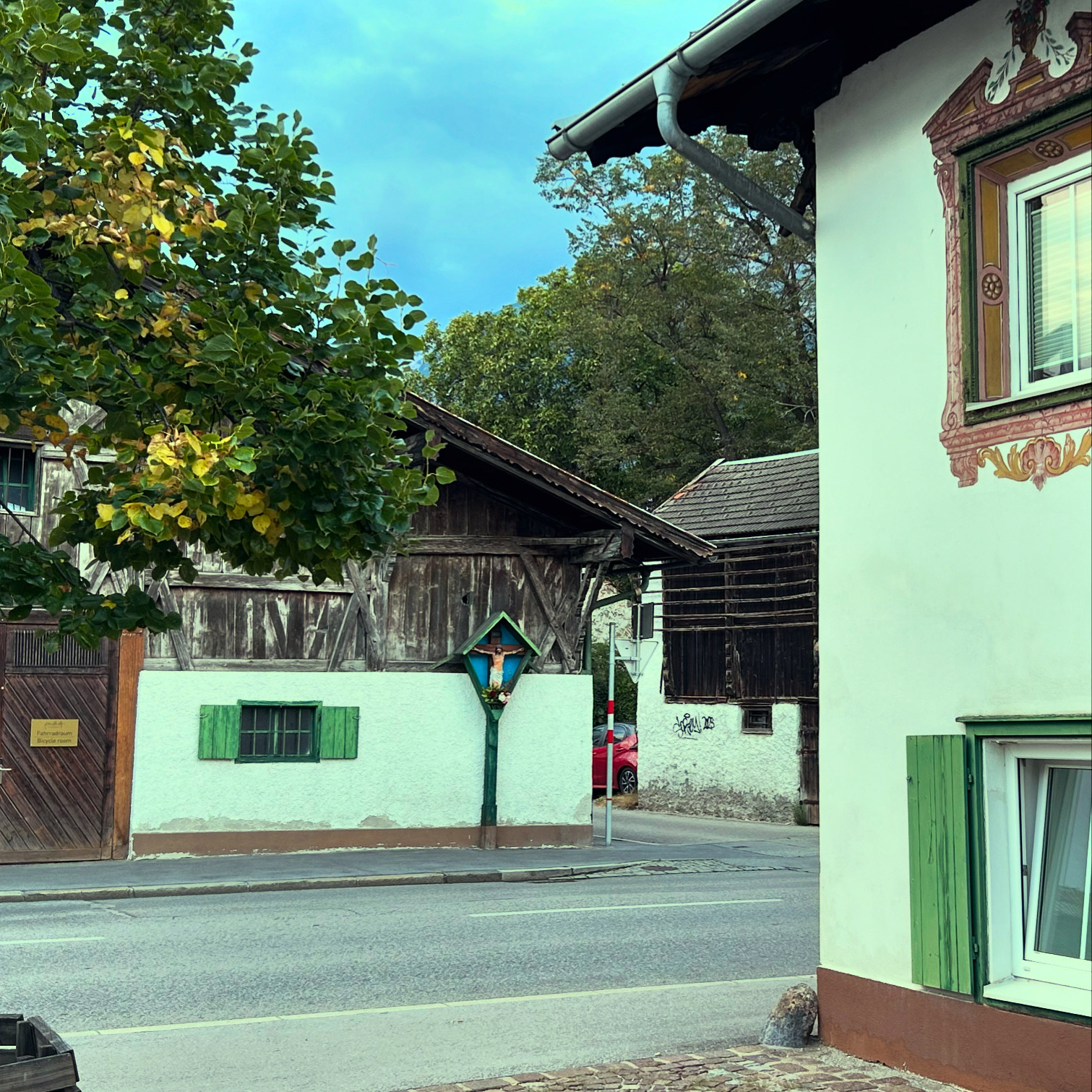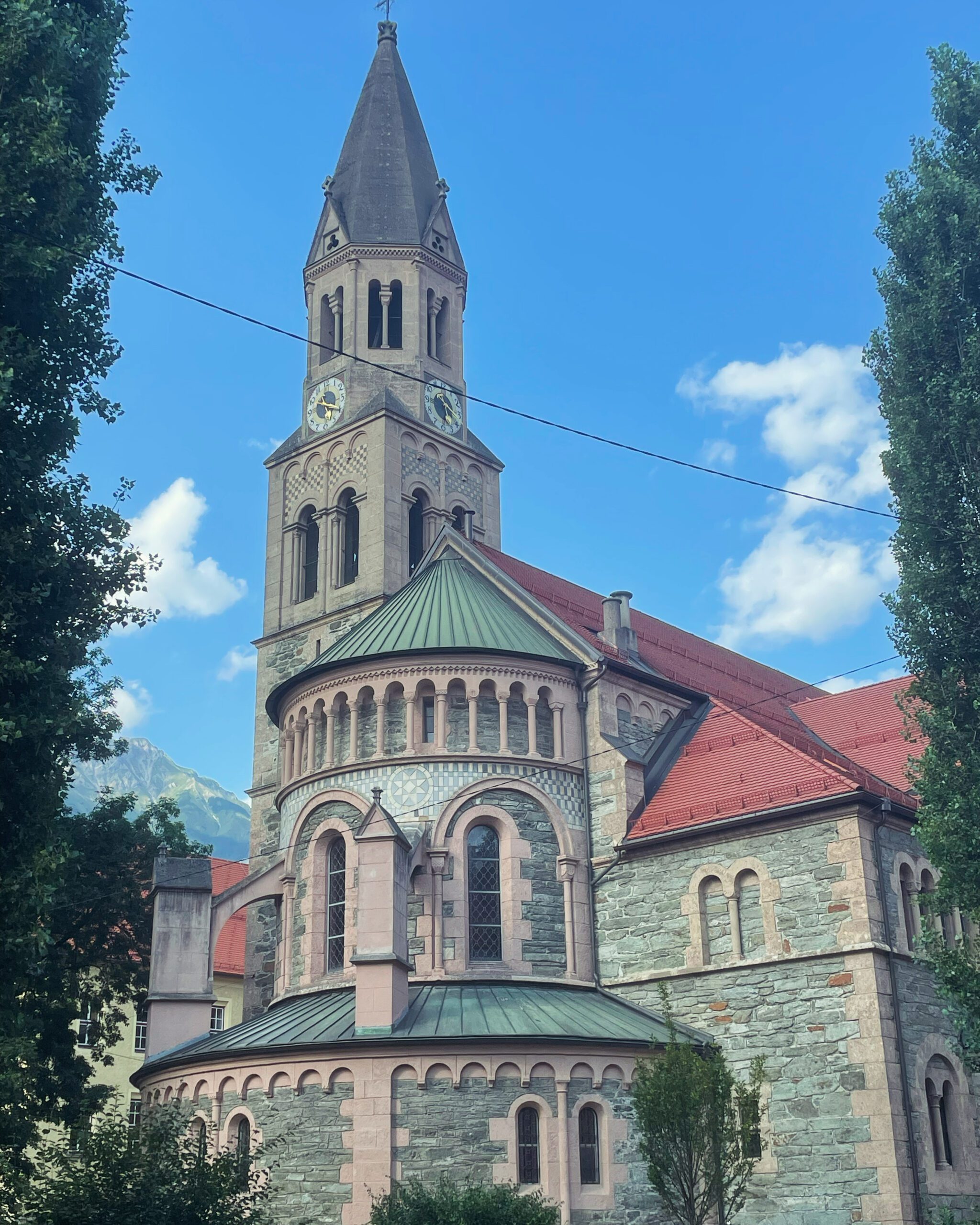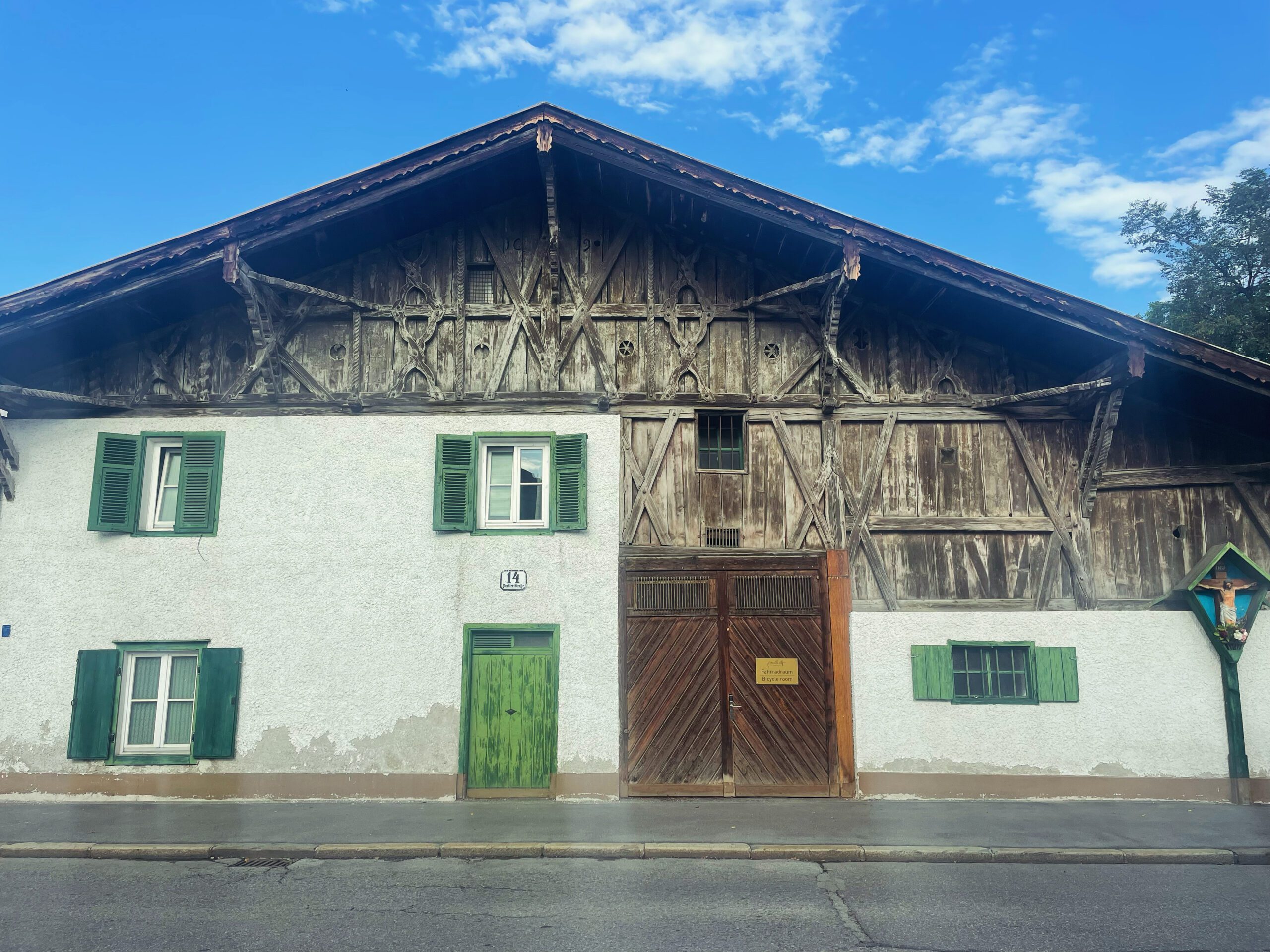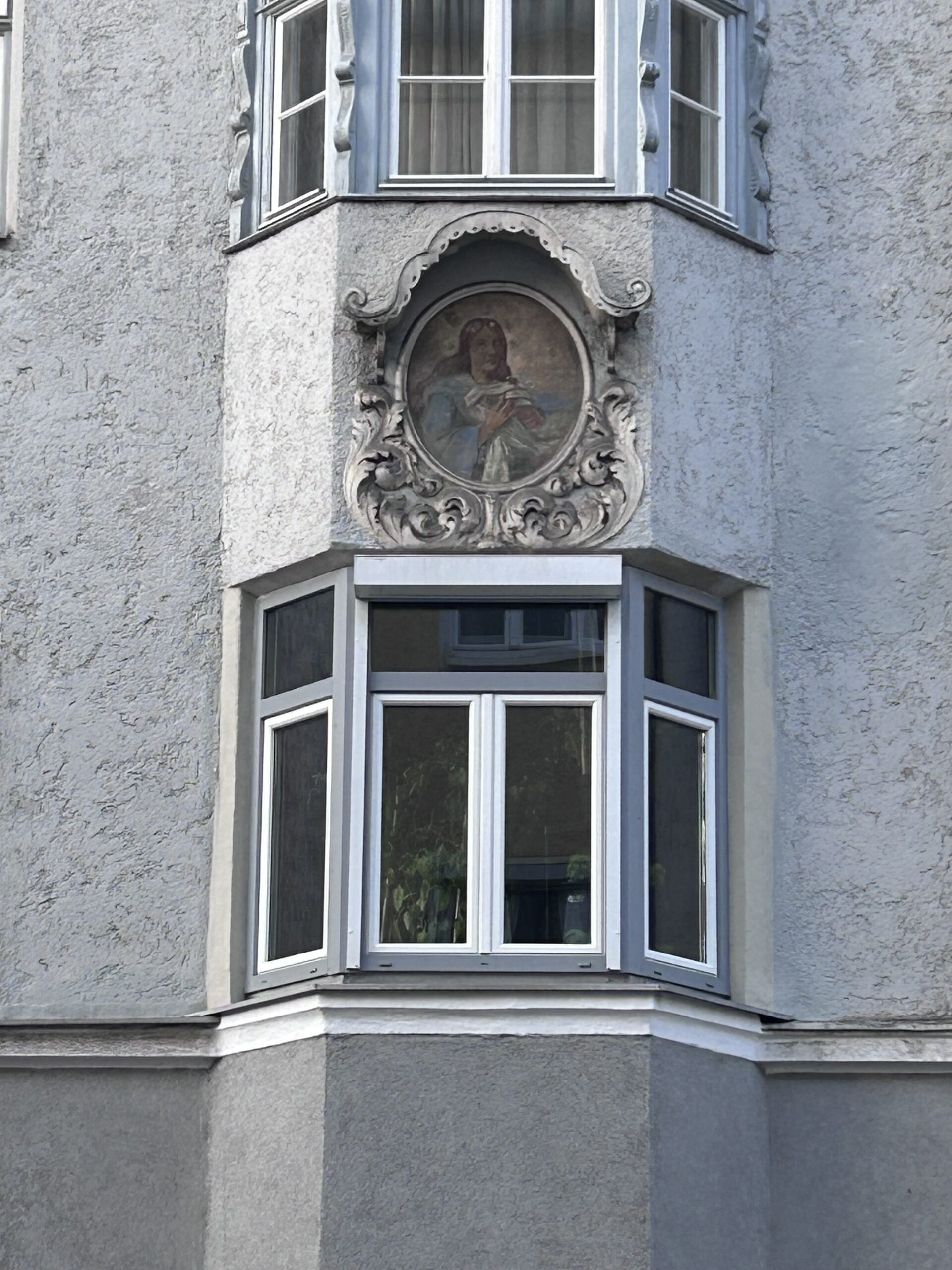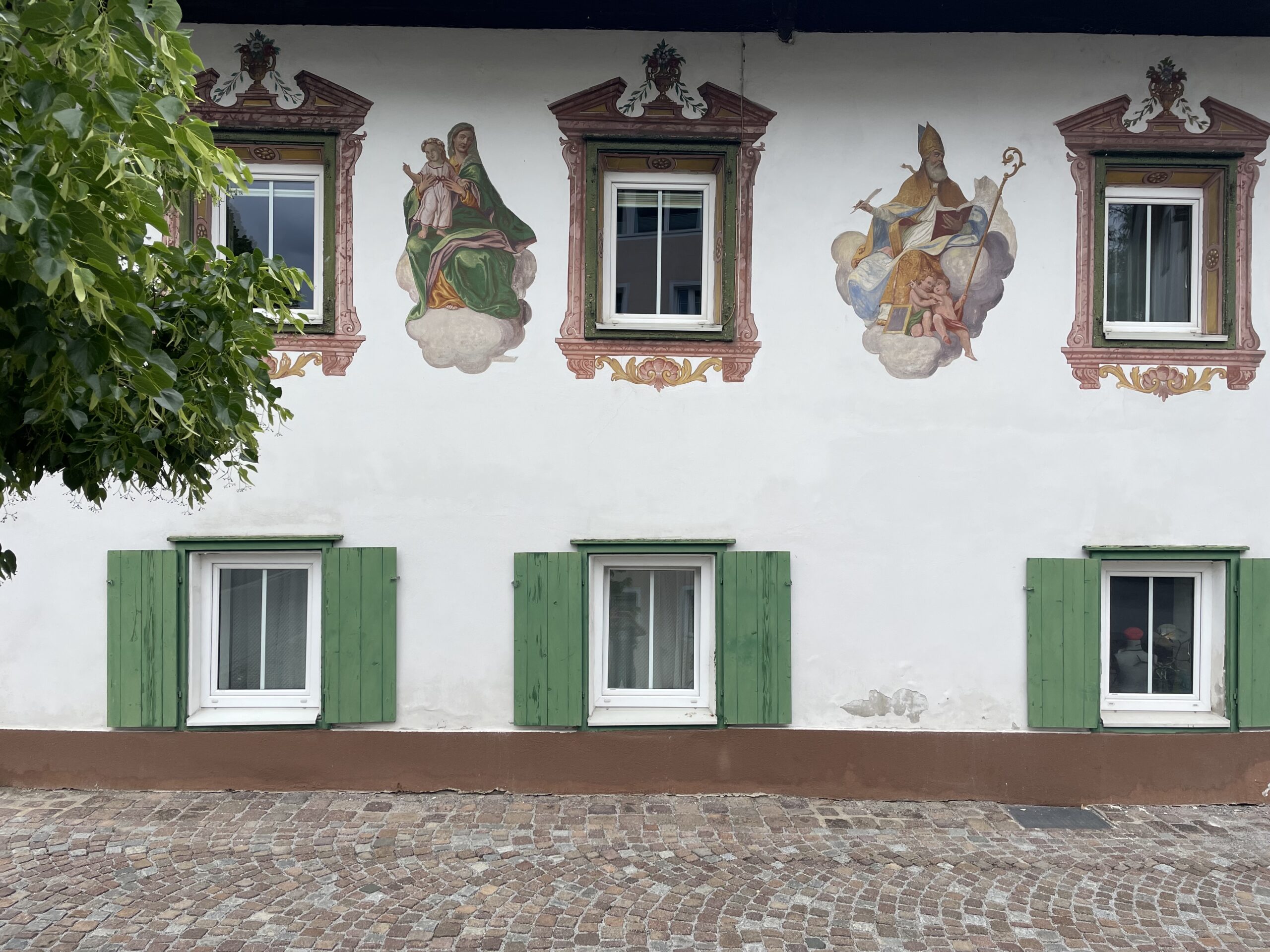Pradlerstraße
Pradlerstraße
Worth knowing
There was already a bridge over the Sill in the early modern period. This was the beginning of the fortified Fürstenwegwhich led all the way to Ambras Castle. The northern part of this early north-south connection is today's Pradlerstraße. A look at the history of this small area tells the story of Innsbruck's development between the 16th and 20th centuries. Throughout the Middle Ages and early modern times, Pradl was one of many small farming villages that supplied the city of Innsbruck with food. The main features of some of the farms have been preserved to this day.
The lovingly renovated façades are well worth seeing. The northern façade of the house at Pradlerstraße 9 on the corner of Reichenauerstraße shows the Mariahilf-Gnadenmuttera copy of Lukas Cranach's painting of Our Lady of Grace, the original of which hangs in Innsbruck Cathedral. This house was also the birthplace of the writer Rudolf Greinz (1866 - 1942), whose Tyrolean local history novels were so popular with readers that a street was named after him in Pradl during his lifetime. The building at number 13 is a baroque, two-storey farmhouse with typical religious rural paintings by Rafael Thaler (1870 - 1947). Opposite is a farmhouse dating back to 1690 according to the gable inscription. The Tyrolean food company Hörtnagl originates from the Hörtnaglhoftoday house number 20, which dates back to the 16th century.
Built in 1865 and extended in 1913 to include the baroque statue of St Florian, the Florianibrunnencreates a small square in the centre of this composition. If you turn eastwards from here into Egerdachstraße, you come to other farmhouses that once made up the old Pradl. The Stamserhof in Hausnummer 10 und der Lodronische Hof in number 11 date back to the 16th century. In the Lodronischen Hof had the Pradler Bauerntheater its place with pieces like Der letzte Rottenburger oder die Tochter des Geächteten Innsbrucker or stagings of the Tyrolean fight for freedom in 1809 attracted many city dwellers to rural Pradl.
As the city expanded, the farmhouses were gradually surrounded by modern apartment blocks and housing estates. This was accompanied by social tensions between the new workers and the "native" Pradlers. Even before Pradl was united with Innsbruck in 1904, large employers such as the Rhomberg silk spinning mill and the gas works had already settled here. Bakeries, butchers, small shops and restaurants opened. Houses and flats were needed for the employees and workers. Between the junctions of Amthorstraße/Pradlerstraße and Gumppstraße/Pradlerstraße there are some remarkable buildings.
House number 32 was the home and workshop of Rafael Thaler, a restorer and artist who was responsible for many façade paintings and frescoes in the Heimatstil style in and around Innsbruck. The building is decorated with his own works. House number 36 is adorned with a depiction of the wine merchant Benedikt Fritz. House number 38 is a marvellous example of the Heimatstil, which was characteristic of Innsbruck's architecture at the time. The wall painting of this corner house, also by Rafael Thaler, depicts two female figures who Trade und Trade represent. The bon mot underneath was an expression of the owners' new bourgeois, but still conservative, self-image.
„Arbeit ist des Bürgers Zierde,
Segen ist der Mühe Preis,
ehrt den König seine Würde,
ehret uns der Hände Fleiß“
As Pradl grew, a new district centre developed between the farmhouses to the north and the residential buildings to the south of Pradlerstrasse around the landmarks of the Pradl extension, the Leitgebule school and the parish church. The growing population not only needed to be provided with work, but also with education and pastoral care. The Leitgebschule was built between 1907 and 1908 according to plans by Eduard Klingler. It was named after the Innsbruck writer Josef Leitgeb (1897 - 1952), whose stories and poems provide an insight into Austria's turbulent interwar period. At first glance, the bulky and sober cube appears surprisingly light, almost classicist in its details on closer inspection.
Where the Leitgebhalle stands today, there was already a small chapel from the late 17th century, built around the copy of Lukas Cranach's Mother of mercy was built from the house where Rudolf Greinz was born. In the 19th century, this church had become too small to accommodate the many new souls in Pradl. The Pradl church was built between 1905 and 1908. The lion portal is impressive. The round, Romanesque arches that characterise the building are very unusual, as churches of this era were mostly built in the neo-Gothic style. A small Christmas market is held on the square in front of the church every year on the Saturday of the first weekend of Advent.
The Gründerzeit houses, turn-of-the-century tenements and old farmhouses are interspersed with many more recent housing projects. Because of its proximity to the railway station, Pradlerstrasse was a victim of the air war. The bronze signs with the inscription
„Dieses Haus wurde in den Kriegsjahren 1939/45 zerstört und aus Fondsmitteln des Bundesministeriums f. Handel u. Wiederaufbau in den Jahren unter dem Bundeskanzler Ing. Julius Raab wiederhergestellt.“
indicate this destruction and the subsequent reconstruction. In the post-war period, Pradl developed into a typical residential neighbourhood for Innsbruck's middle class.
Since the 1990s, Pradlerstrasse has suffered the typical fate of city centre districts in Europe. Long-established commercial and retail businesses are no longer being taken over, new shops often open only to close again shortly afterwards. Shopping is no longer done locally, but in the shopping centres on the outskirts of the city or in Sillpark. Traffic from the 1960s onwards also contributed to this. During the Bavarian occupation at the time of the Napoleonic Wars, the street was adorned with papules on both sides. The avenue was poorly maintained, especially in the financially straitened interwar period, and fell into noticeable disrepair. When the road was widened in the 1960s, the trees were finally sacrificed to car traffic, which for some years now people have been keen to curb again in order to make the street more attractive.
Eduard Klingler: The master builder of expansion
If Wilhelm Greil is considered the mayor of the extension, the Viennese-born Eduard Klingler (1861 - 1916) probably deserves the title of its architect. Klingler had a major influence on the cityscape of Innsbruck. He began working for the state of Tyrol in 1883. In 1889 he joined the municipal building authority, becoming its head in 1902. During this period of economic boom, the city began to expand. The two previously independent neighbouring communities of Pradl and Wilten were incorporated in 1904, which contributed massively to its growth. From 1880 to 1900, Innsbruck's population "only" grew from 20,000 to 26,000 inhabitants, while Wilten tripled from 4,000 to 12,000.
The rapid increase in population presented the city administration with major challenges. In addition to the quantitative growth caused by the expansion of the city, Innsbruck also "grew" qualitatively in terms of people's quality of life. The city pushed ahead with building activity. Gas, water and electricity began to become standard. Schools and kindergartens had to be built for the new residents. The demands on medicine and thus the clinic grew. In Innsbruck, the commercial academy, the Leitgebschule, the Pradl cemetery, the dermatological clinic on the hospital grounds, the municipal kindergarten in Michael-Gaismair-Straße, the Trainkaserne (note: today a residential building) and the Tyrolean State Conservatory are on Klingler's account as head of the municipal building department. The Ulrichhaus on Mount Isel, which today houses the Alt-Kaiserjäger-Club, is a building in the local style that is well worth seeing.
The first free elections to the Imperial Council for all male citizens in 1907 changed the social rules of the game. The housing that was built in the working-class neighbourhoods was a reflection of a new society. Workers and employees with political voting rights had different needs than subjects without this right. Unlike in rural Tyrol, where farming families and their servants lived in farmhouses as a clan, life in the city came close to the family life we know today. The lifestyle of city dwellers demanded multi-room flats.
However, the social divide manifested itself not only in the functionality of the flats, but also in the architecture. In keeping with the spirit of the time, the projects were designed in the styles of historicism, classicism and Heimatstil. Until the outbreak of the First World War, clear forms, masks, statues and columns were style-defining elements in the design of new buildings. The ideas that architects had of classical Greece and ancient Rome were realised in a sometimes wild mix. Not only public buildings, but also large apartment blocks and even entire streets such as Sonnenburgstraße, Grillparzerstraße, Stafflerstraße, Kaiser-Josef-Straße and Claudiastraße reflect the style of the time.
Wilhelm Greil: DER Bürgermeister Innsbrucks
One of the most important figures in the town's history was Wilhelm Greil (1850 - 1923). From 1896 to 1923, the businessman held the office of mayor, having previously helped to shape the fortunes of the town as deputy mayor. In politics, the second half of the 19th century was characterised by the struggle between liberal and conservative forces. Unlike in the rest of Tyrol, the conservatives had a hard time in Innsbruck, whose population had been breathing in the liberal morning air since the Napoleonic era. Each side not only had politicians, but also associations and their own newspapers. Taxes, social policy, education, housing and the organisation of public space were discussed with passion and zeal. Due to an electoral system based on voting rights via property classes, only around 10% of the entire population of Innsbruck could go to the ballot box. Relative suffrage applied within the three electoral bodies, which means as much as: The winner takes it all. Mass parties such as the Social Democrats were unable to assert themselves until the electoral law reform of the First Republic. Mayors like Greil could rely on 100% support in the municipal council, which naturally made decision-making and steering much easier.
Greil belonged to the "Deutschen Volkspartei", a liberal and national-Great German party. What appears to us today as a contradiction, liberal and national, was a politically common and well-functioning pair of ideas in the 19th century. Pan-Germanism was not a political peculiarity of a radical right-wing minority, but rather a centrist trend, particularly in German-speaking cities of the Reich, which was important in varying forms through almost all parties until after the Second World War. Whoever issues the liberal Innsbrucker Nachrichten of the period around the turn of the century, you will find countless articles in which the common ground between the German Reich and the German-speaking countries was made the topic of the day.
Greil was a skilful politician who operated within the predetermined power structures of his time. He knew how to skilfully manoeuvre around the traditional powers, the monarchy and the clergy, and how to come to terms with them. The period leading up to the First World War was characterised by a general economic boom. This gave him a great deal of room for manoeuvre. Under him, the city purchased land with foresight in the spirit of the merchant in order to make projects possible. Innsbruck expanded considerably under Wilhelm Greil. Albert Gruber gave a warning speech about this growth in 1907, in which he warned against uncontrolled growth in urban planning and land speculation.
"It is the most difficult and responsible task facing our city fathers. Up until the 1980s (note: 1880), let's say in view of our circumstances, a certain slow pace was maintained in urban expansion. Since the last 10 years, however, it can be said that cityscapes have been expanding at a tremendous pace. Old houses are being torn down and new ones erected in their place. Of course, if this demolition and construction is carried out haphazardly, without any thought, only for the benefit of the individual, then disasters, so-called architectural crimes, usually occur. In order to prevent such haphazard building, which does not benefit the general public, every city must ensure that individuals cannot do as they please: the city must set a limit to unrestricted speculation in the area of urban expansion. This includes above all land speculation."
The politician Greil was able to rely on the civil servants and town planners Eduard Klingler, Jakob Albert and Theodor Prachensky for the major building projects of the time. Further development with individual houses was no longer possible due to population growth. In 1898, it was decided to build only blocks of flats east of Claudiastrasse instead of the orderly cottage-style villas of the decades after 1850. Infrastructure projects such as the new town hall in Maria-Theresienstraße in 1897, the Hungerburg railway in 1906 and the Karwendelbahn were realised. Other projects included the renovation of the market square and the construction of the market hall.
Much of what was pioneered in the second half of the 19th century is part of everyday life today. For the people of that time, however, these things were a real sensation and life-changing. The four decades between the economic crisis of 1873 and the First World War were characterised by unprecedented economic growth and rapid modernisation. The city's economy boomed. Businesses were founded in Pradl and Wilten and attracted workers. Tourism also brought fresh capital into the city. At the same time, however, the concentration of people in a confined space under sometimes precarious hygiene conditions also brought problems. The outskirts of the city in particular were repeatedly plagued by typhus.
His predecessor, Mayor Heinrich Falk (1840 - 1917), had already contributed significantly to the modernisation of the town and the settlement of Saggen. Since 1859, the lighting of the city with gas pipelines had progressed steadily. Between 1887 and 1891, Innsbruck was equipped with a modern high-pressure water pipeline, which could also be used to supply flats on higher floors with fresh water. Wilhelm Greil arranged for the gas works in Pradl and the electricity works in Mühlau to be taken over into municipal ownership. The street lighting was converted to electric light.
Greil was able to secure Innsbrucker Renaissance on patrons from the town's middle classes. Baron Johann von Sieberer donated the old people's asylum and the orphanage in Saggen. Leonhard Lang donated the building, previously used as a hotel, to which the town hall moved from the old town in 1897, in return for the town's promise to build a home for apprentices.
In his last years in office, Greil accompanied Innsbruck through the transition from the Habsburg Monarchy to the Republic, a period characterised above all by hunger, misery, scarcity of resources and insecurity. He was 68 years old when Italian troops occupied the city after the First World War and Tyrol was divided at the Brenner Pass, which was particularly bitter for him as a representative of German nationalism.
In 1928, former mayor Greil died as an honorary citizen of the city of Innsbruck at the age of 78. Wilhelm-Greil-Straße was named after him during his lifetime.
Innsbruck's industrial revolutions
Im 15. Jahrhundert begann sich in Innsbruck eine erste frühe Form der Industrialisierung zu entwickeln. Glocken- und Waffengießer wie die Löfflers errichteten in Hötting, Mühlau und Dreiheiligen Betriebe, die zu den führenden Werken ihrer Zeit gehörten. Unternehmer waren zwar nicht von edlem Blut, sie hatten aber oft mehr Kapital zur Verfügung als die Aristokratie. Die alten Hierarchien bestanden zwar noch, begannen aber zumindest etwas brüchig zu werden. Die Industrie änderten nicht nur die Spielregeln im Sozialen durch den Zuzug neuer Arbeitskräfte und ihrer Familien, sie hatte auch Einfluss auf die Erscheinung Innsbrucks. Die Arbeiter waren, anders als die Bauern, keines Herren Untertanen. Sie brachten neue Mode mit und kleideten sich anders. Kapital von außerhalb kam in die Stadt. Wohnhäuser und Kirchen für die neu zugezogenen Untertanen entstanden. Die großen Werkstätten veränderten den Geruch und den Klang der Stadt. Die Hüttenwerke waren laut, der Rauch der Öfen verpestete die Luft.
Die zweite Welle der Industrialisierung erfolgte im Verhältnis zu anderen europäischen Regionen in Innsbruck spät. Das Kleine Handwerk, bäuerliche Herstellung in der feldfreien Zeit, und die ehemaligen Handwerksbetriebe der Stadt entwickelten sich nach und nach zu eigenen Unternehmen. Teils waren es Innsbrucker Unternehmen, teils kamen die Betriebe von außerhalb. Manche Angehörigen des Kleinadels investierten das Geld, das sie nach 1848 als Ablöse für ihre Ländereien im Rahmen der Grundentlastung erhalten hatten, in Industrie und Wirtschaft. Landwirte ohne Land machten sich vom Umland auf nach Innsbruck, um dort Arbeit zu finden.
In Wilten, Mühlau und Pradl, damals noch nicht Teil der Stadt, entstanden entlang des Mühlbaches und des Sillkanals Fabriken. 1838 kam die Spinnmaschine über die Dornbirner Firma Herrburger & Rhomberg über den Arlberg nach Pradl. H&R hatte ein Grundstück an den Sillgründen erworben. Der Platz eignete sich dank der Wasserkraft des Flusses ideal für die schweren Maschinen der Textilindustrie. Neben der traditionellen Schafwolle wurde nun auch Baumwolle verarbeitet.
Über 20 Betriebe nutzten den Sillkanal um 1900. Der Lärm und die Abgase der Motoren waren für die Anrainer die Hölle, wie ein Zeitungsartikel aus dem Jahr 1912 zeigt:
„Entrüstung ruft bei den Bewohnern des nächst dem Hauptbahnhofe gelegenen Stadtteiles der seit einiger Zeit in der hibler´schen Feigenkaffeefabrik aufgestellte Explosionsmotor hervor. Der Lärm, welchen diese Maschine fast den ganzen Tag ununterbrochen verbreitet, stört die ganz Umgebung in der empfindlichsten Weise und muß die umliegenden Wohnungen entwerten. In den am Bahnhofplatze liegenden Hotels sind die früher so gesuchten und beliebten Gartenzimmer kaum mehr zu vermieten. Noch schlimmer als der ruhestörende Lärm aber ist der Qualm und Gestank der neuen Maschine…“
Wie 400 Jahre zuvor veränderte auch die Zweite Industrielle Revolution die Stadt nachhaltig. Stadtteile wie Mühlau, Pradl und Wilten wuchsen rasant. Während sich die neue vermögende Unternehmerklasse Villen in Wilten, Pradl und dem Saggen bauen ließ und mittlere Angestellte in Wohnhäusern in denselben Vierteln wohnten, waren die Arbeiter in Arbeiterwohnheimen und Massenunterkünften untergebracht. Die einen sorgten in Betrieben wie dem Gaswerk, dem Steinbruch oder in einer der Fabriken für den Wohlstand, während ihn die anderen konsumierten. Schichten von 12 Stunden in engen, lauten und rußigen Bedingungen forderten den Arbeitern alles ab. Zu einem Verbot der Kinderarbeit kam es erst ab den 1840er Jahren. Frauen verdienten nur einen Bruchteil dessen, was Männer bekamen. Die Arbeiter wohnten oft in von ihren Arbeitgebern errichteten Mietskasernen und waren ihnen mangels eines Arbeitsrechtes auf Gedeih und Verderb ausgeliefert. Es gab weder Sozial- noch Arbeitslosenversicherungen. Wer nicht arbeiten konnte, war auf die Wohlfahrtseinrichtungen seines Heimatortes angewiesen. Zur Bildung einer bedeutenden Arbeiterbewegung wie in Wien kam es in Tirol trotzdem nie. Innsbruck war immer schon vorwiegend Handels- und Universitätsstadt. Zwar gab es Sozialdemokraten und eine Handvoll Kommunisten, die Zahl der Arbeiter war aber immer zu klein, um wirklich etwas zu bewegen.
Die Industrialisierung betraf aber nicht nur den materiellen Alltag. Innsbruck erfuhr eine Gentrifizierung wie man sie heute in angesagten Großstadtvierteln wie dem Prenzlauer Berg in Berlin beobachten kann. Der Wechsel vom bäuerlichen Leben des Dorfes in die Stadt beinhaltete mehr als einen örtlichen Wechsel. Wie die Menschen die Verstädterung des ehemals ländlichen Bereichs erlebten, lässt uns der Innsbrucker Schriftsteller Josef Leitgeb in einem seiner Texte wissen:
„…viel fremdes, billig gekleidetes Volk, in wachsenden Wohnblocks zusammengedrängt, morgens, mittags und abends die Straßen füllend, wenn es zur Arbeit ging oder von ihr kam, aus Werkstätten, Läden, Fabriken, vom Bahndienst, die Gesichter oft blaß und vorzeitig alternd, in Haltung, Sprache und Kleidung nichts Persönliches mehr, sondern ein Allgemeines, massenhaft Wiederholtes und Wiederholbares: städtischer Arbeitsmensch. Bahnhof und Gaswerk erschienen als Kern dieser neuen, unsäglich fremden Landschaft.“
Für viele Innsbrucker kam es nach dem Revolutionsjahr 1848 und den neuen wirtschaftlichen Gegebenheiten zu einer Verbürgerlichung. Erfolgreiche Unternehmer übernahmen die einstige Rolle der adeligen Grundherren. Gemeinsam mit den zahlreichen Akademikern bildeten sie eine neue Schicht, die auch politisch mehr und mehr Einfluss gewann. Beda Weber schrieb dazu 1851:
„Their social circles are without constraint, and there is a distinctly metropolitan flavour that is not so easy to find elsewhere in Tyrol."
Auch die Arbeiter verbürgerlichten. War der Grundherr am Land noch Herr über das Privatleben seiner Knechte und Mägde und konnte bis zur Sexualität über die Freigabe zur Ehe über deren Lebenswandel bestimmen, waren die Arbeiter nun individuell zumindest etwas freier. Sie wurden zwar nur schlecht bezahlt, immerhin erhielten sie aber nun ihren eigenen Lohn anstelle von Kost und Logis und konnten ihre Privatangelegenheiten für sich regeln ohne grundherrschaftliche Vormundschaft.
Das bis dato unbekannte Phänomen der Freizeit kam, wenn auch für den größten Teil nur spärlich, auf und begünstigte gemeinsam mit frei verfügbarem Einkommen einer größeren Anzahl an Menschen Hobbies. Vereine aller Art gründeten sich.
Parks wie der Englische Garten beim Schloss Ambras waren nicht mehr exklusiv der Aristokratie zugänglich, sondern dienten den Bürgern als Naherholungsgebiete vom beengten Dasein. Neue Parks wie der Waltherpark in St. Nikolaus entstanden. In der gegenüberliegenden St.-Nikolaus-Gasse und in vielen vielen Mietzinshäusern in Wilten und Pradl haben sich vereinzelt Häuser erhalten, die einen Eindruck vom Alltag der Innsbrucker Arbeiterschaft geben.
